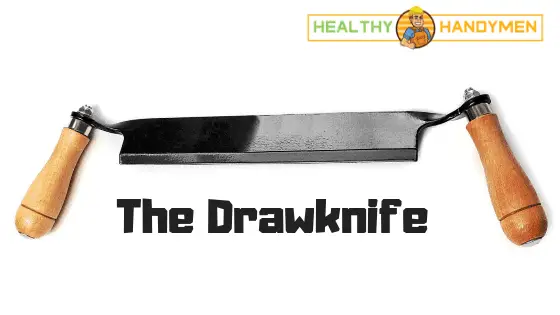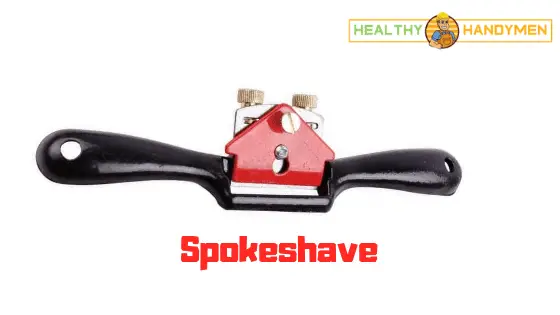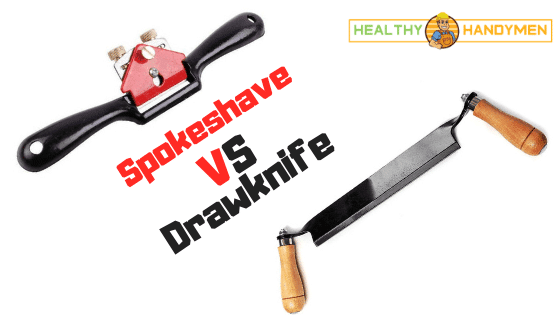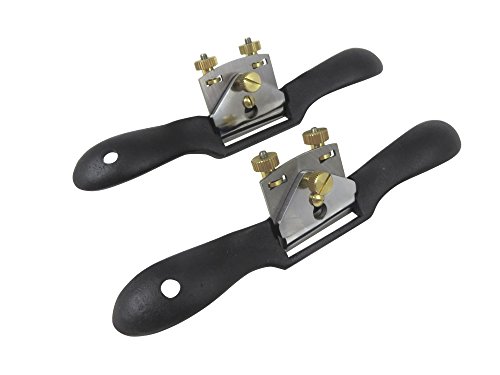For a dedicated woodworker, having a decent selection of tools is a must. Drawknives and spokeshaves have so many things in common that this makes it challenging to choose which one between the two is ideal for your projects.
If you are like most woodworkers, you will use the two tools interchangeably. Still, is the drawknife better than the spokeshave, or is it the other way around?
Let’s dive right into study the features, functions, and cons of both tools as well as the kind of work they do best. After this brief spokeshave vs drawknife comparison, it should be easier for you to identify the device that best matches your needs.
Spokeshave vs Drawknife
The Drawknife

There are two kinds of drawknives, the curved and the straight blades. Both can be used interchangeably for more or less the same applications. When working on projects that involve hollowing out the surface, you can start by using the straight blade and then achieve that deeper cut using the curved blade.
In this case, the blade (either curved or straight) is positioned between two sturdy handles. These handles resemble the grips of a bike. The blade allows you to remove large chunks or slices of wood by pulling your tool towards you.
Even though this device is commonly used to trim beams, chamfer edges, and de-bark trees, it can also be used to carve out wooden structures, such as chair seats.
You can use your drawknife with the bevel facing down or up. When the bevel faces downwards, the blades make cuts that rise from the wood. This allows you to make thicker shavings when hollowing out a wooden surface. While using this method, the blade tends to get dull faster.
When using your drawknife with the bevel facing upwards, you will have greater control over your device. This should make it easy to make deeper cuts or remove more delicate shavings.
This tool is an all-rounder in woodworking projects because it can remove big chunks as well as slices of wood from a plank. On the downside, a woodworker without advanced skills and precision may find it challenging to use the device effectively.
Read also: Mallet vs Hammer
Here’s the list of Best Draw Knives on Amazon today?
- Multipurpose shaving device (can remove thin or thicker wood shavings)
- Makes completing projects less time consuming
- Delivers accurate and precise shaves
- Ideal for final smoothing and shaping
- The blades need regular sharpening
- To effectively use the device, advanced skills are necessary
The Spokeshave

A spokeshave is used for shaping, shaving, and smoothing wood. However, it is more instrumental when working on curved pieces of wood, such as bows and arrows, canoe paddles, chair legs, or even wheel spokes. There are four types of spokeshaves, and each of them is ideal for different applications.
Round spokeshaves as the name suggests have rounded soles and flat blades. They help to create perfect inward curves. The convex shaves have convex soles and blades. They create outward curves and are ideal for hollowing out pieces of wood.
Flat spokeshaves, on the other hand, have a flat blade and sole. They are mainly used on outward curves, though they can also come in handy when working on flat surfaces.
Finally, there are concave spokeshaves that come with curved soles and blades. They are best used for inward curves, corners, and round woodwork pieces.
Spokeshaves have been in use for centuries. They have handles that extend from the center and assume the shape of wings. Using this device is easy, and you can create fine cuts and shape your wood as desired.
As different planes are used for various applications, there are instances when you may have to use more than one spokeshave type during a project. I strongly recommend having several device types that differ in shape and size in your toolbox.
When compared to the drawknife, the spokeshave is smaller in size. The handles are closer to the relatively more minor blade, although this is what makes it easier to control.
Another interesting read: Aviation Snips vs Tin Snips
Here’s the Best Spokeshaves on Amazon today?
- The device offers easy control
- Helps to produce more refined and precise work
- Minimal upkeep is needed
- Allows you to get to hard to reach areas such as the edges of woodwork pieces
- Shavings are finer, and this makes projects more time consuming
Spokeshave vs Drawknife: Which One is the Best?
I believe that the drawknives and spokeshaves are designed to complement each other. After all, their functions are almost alike, and in some instances, they can be used interchangeably.
For instance, if you are working on a chair woodworking project, you will need the drawknife to shape the planks. The spokeshave will then come in handy when carving the wood to create the desired design.
When comparing these two tools, their main difference is in the level of control that one has when making cuts. The drawknife creates rougher cuts and chops off more wood, speeding up the completion of a project. On the other hand, your spokeshave will help you make the final, smaller but smoother cuts.
For newbies in woodworking, it pays first to get well acquainted with how to use the spokeshave. This device gives you better control, and it’s easier to maneuver when creating intricate details on your wood. You need more skill to use the drawknife without curving too much of your planks.
It is hard to say that the drawknife is better than the spokeshave or the other way around. The best tool to use will highly depend on your needs, skill level, and the requirements of your woodworking project.
Final Words
I love to think of myself as more than just a DIY star or a weekend warrior. Even though I have earned my woodworking skills mainly from watching YouTube tutorials, I believe my years of experience qualify me to sit on the table of skilled woodworkers.
Find both drawknives and spokeshaves to be useful tools. I have a range of both devices in my toolbox and use them interchangeably depending on my needs and applications.
So, what’s my verdict in the Spokeshave vs. Drawknife debate? From my very qualified perspective, both tools are comparable in terms of their woodworking uses and benefits.







